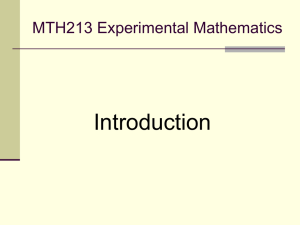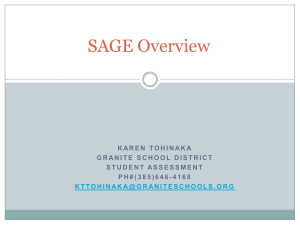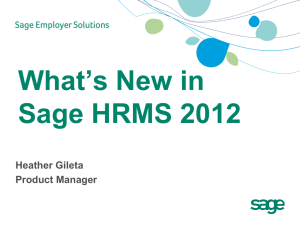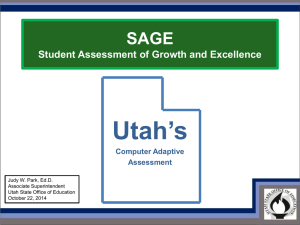SAGE_Testing-Information-Session
advertisement
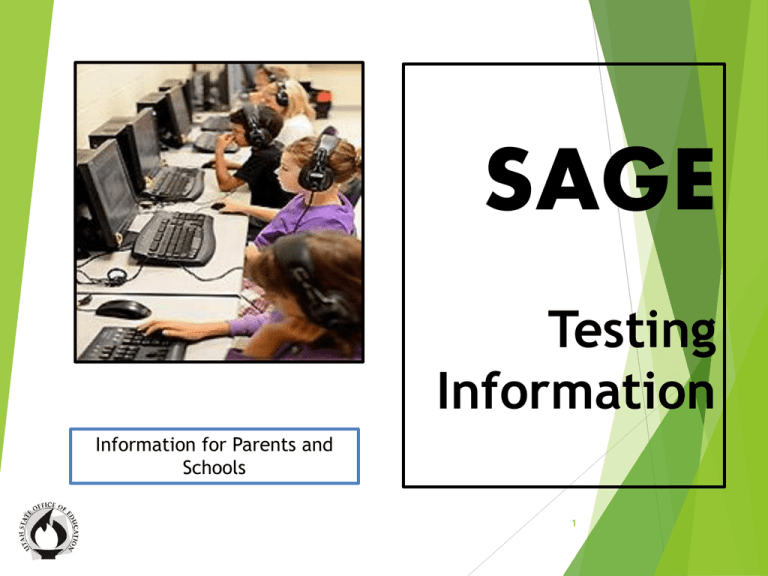
SAGE Testing Information Information for Parents and Schools 1 SAGE is a computer adaptive test What is a computer adaptive test? Every time a student answers a question, his or her response helps determine the next question that the student must answer. The difficulty of the test will adjust to each student’s skills, providing a better measure of what each student knows and can do. There is a continuum of questions, easy to hard, to determine what each student knows and can do. When students answer harder questions it gives them higher scores than answering easy questions SAGE is a Utah test, with the test items having been developed by Utah educators. 2 SAGE is a computer adaptive test Every student has a similar testing experience Individualized: each student has easy through difficult questions The test will be more precise: the test will become more accurate each year as student responses and test question data are analyzed Every student will be assessed: in language arts, math and science on all standards in their grade/course at all levels of critical thinking using the same number of questions 3 What does the term “more rigorous standards” mean? Students used to: Now, in addition: Recall Cite evidence Recognize Apply concepts Identify Analyze Synthesize Alpine teachers are teaching to these standards now... Examples -- Old 12÷3=? A. 36 B. 4 C. 3 D. 9 Examples -- SAGE Examples -- SAGE Examples -- SAGE Examples -- Old Solve the system of equations: 3x + 4y = 12 5x – 8y = 18 A. x=36, y=12 B. x=4, y=9 C. x=3, y=4 D. x=6, y=3 Examples -- SAGE SAGE Training Tests Located at www.sageportal.org Purpose Audience The intention of the training test is to teach students how to use each of the different item types. Students are experiencing these kinds of items in practice sessions throughout the year Parents can experience the test items Scoring The training test will not score student submissions. 11 SAGE Results Reality Reduced proficiency is a result of: more rigorous standards more rigorous assessments raising the bar and establishing new baseline data We expect proficiency will drop, on average, about twenty percentage points as a new baseline is established Proficiency will increase over time as students, parents, and teachers work together to implement the standards and assessments and make instructional decisions based upon the student data. 12 SAGE is an assessment "SYSTEM" Summative (starting Spring 2014) Spring adaptive assessments 3rd-11th Grade in Language Arts 3rd Grade - Secondary Math 3 in Math 4th Grade – Physics/Chemistry in Science 3rd-11th Grade in Writing Used for state reporting and accountability reports In Spring 2014 results come in the Fall (for this 1st year) After Spring 2014 results are immediate 13 SAGE is an assessment "SYSTEM" Interim Adaptive Tests (starting Fall 2014) Given in the fall Will show fall to spring growth Alpine will give the following interim tests: 3rd grade math and language arts 4th grade science 7th grade math, language arts, and science High school Secondary I, II, and III math Schools have the option to give other fall tests 14 SAGE is an assessment "SYSTEM" Formative SAGE Teacher created assessments for classroom/grade/department use Teacher instructional resources (ex., sharing of teacher lesson plans) Example Mr. Smith just completed an 8th grade science unit on rocks and he wants to create an assessment to check for understanding with his students. He could use Formative SAGE to write questions, pick already written questions or borrow questions from other teachers. He would use Formative SAGE to administer the assessment. 15 Benefits of SAGE Testing The SAGE Assessment Supports Student Learning: Emphasis on student learning Identifies student learning levels Gives information to teachers to improve student instruction Gives information to parents about a student's academic achievement and skills Establishes the student's baseline learning levels to determine student growth 16 All Students Are Expected to Participate in the SAGE Assessment Parents may choose to not have their students participate in testing. Students who opt out will be given a score of 1 (out of 4) Students who have opted out will still be counted toward the 95% participation requirement Students who are sick on the day of the test will be expected make up the test when they return All students enrolled in a public school are included in the aggregate data submitted to the state, whether they test or not Students not participating in SAGE, will not receive test results 17



